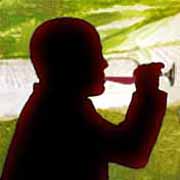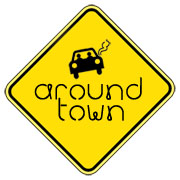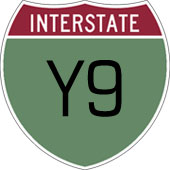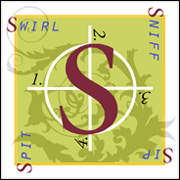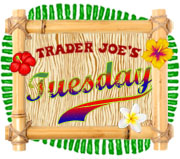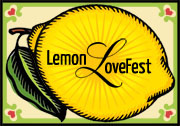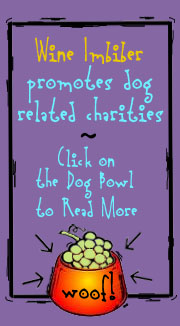|
15 Sep
2010 |
Enjoy Bordeaux 
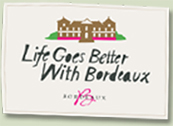 In late July, I received an email through our website from a marketing agency for EnjoyBordeaux.com asking if I’d review this year’s Bordeaux–sampling kit called “Life Goes Better with Bordeaux”. They wanted me to taste the wines (“priced under $35″) and “to share your experience with sampling the bottles (whether positive or negative)”. They were hoping I would inform our readers that “Bordeaux is an affordable, enjoyable, everyday wine, perfect for every dinner table”. I wrote back that they were welcome to send me the wines, but I gave no guarantee that I would write anything. In early August, the package arrived, followed by a second email asking me to confirm that I had received the package, which I had received and put aside, until now.
In late July, I received an email through our website from a marketing agency for EnjoyBordeaux.com asking if I’d review this year’s Bordeaux–sampling kit called “Life Goes Better with Bordeaux”. They wanted me to taste the wines (“priced under $35″) and “to share your experience with sampling the bottles (whether positive or negative)”. They were hoping I would inform our readers that “Bordeaux is an affordable, enjoyable, everyday wine, perfect for every dinner table”. I wrote back that they were welcome to send me the wines, but I gave no guarantee that I would write anything. In early August, the package arrived, followed by a second email asking me to confirm that I had received the package, which I had received and put aside, until now.
That second email also contained tasting notes for the two wines:
Lamothe de Haux 2009 (white): Full bodied and not at all shy. Peaches, mangoes and lemon flavors on the nose, before leading to a nice minerality, counter balanced with sweet florals (honeysuckle) and lychee flavors. Crisp on the finish, well balanced.
Chateau Greysac 2006 (red): Black cherry and cassis, hints of spice, classy oak, very food-friendly and drinking beautifully now. Very light wine with anise and red fruit. Elegant and soft. Good value.
Tasting notes are really only useful if you know the tendencies of the taster. I found the description of the white wine to be pretty accurate. For the red wine, however, the only parts I agreed with were “light wine” and “red fruit” (I note that some earlier vintages of this red wine received good reviews). My detailed impressions are listed below in this article.
Château Lamothe de Haux is in the vicinity of the commune of Haux, near the Garonne River, a bit southeast of the City of Bordeaux (which is at the southwestern coast of France). The area’s climate is relatively mild due to the area’s proximity to the Atlantic Ocean. Springs are mild and damp and summers are warm to hot with occasional rainfall. Nevertheless, weather in the Bordeaux region can vary quite a bit from year to year, which leads to variable wine quality from vintage to vintage.
According to its label, this white wine is from the Appellation Bordeaux Contrôlée (or Bordeaux AC). Their website indicates that their red wine is from the Premières Côtes de Bordeaux appellation. A nice video on their website indicates (though my French is rusty) that they are situated Entre–Deux–Mers (yet another appellation), which means “between two seas”—a reference to the fact that this wine–growing region is located between the Garonne River at the west and the Dordogne River at the east. Looking at a map, this Château is near the borders of all three appellations. I’ll go with what the label says, since that is regulated.
The wine label also states that this wine is “mis en bouteille au Château”, what we in the USA call “estate bottled”, which gives some level of comfort that, on average, a wine may be better, or at least more consistent, than other wines that are not estate bottled. Of course, it is only one factor to use as a rough screen; it doesn’t always work.
The Château Lamothe estate, on a clay-limestone slope, has belonged to the same family since 1956—for three generations. Anne and Fabrice Néel took over the estate in 1972 from Anne’s father. Since 1997, they’ve been assisted by their daughter, Maria, and her husband, Damien Chombart. (Maria and Damien’s daughter, Valentine, has a cuvèe named for her, so I guess she will represent another generation.) Anne and Fabrice began with six hectares in 1972 and their three estates—Château Lamothe and neighboring Château Manos (they manage it) and Château Sauvage (they cellar it), all under the name “Les Caves du Château Lamothe de Haux”—now total 85 hectares. Their website explains that the family expanded the vineyards, rebuilt the cellars, and use the underground galleries (i.e., cellaring caves under the house) that were originally excavated in the 17th and 18th centuries to extract stone used to build some of the most beautiful buildings in the City of Bordeaux. The house, rebuilt in the 19th century, is also a bed & breakfast inn that you can see on their website.
Today, their vineyards consist of 59 hectares of red wine varieties (60% merlot, 30% Cabernet Sauvignon and 10% Cabernet Franc) and 26 hectares of white wine varieties (40% Sauvignon Blanc, 40% Semillon and 20% Muscadelle), the white grape proportions being their Bordeaux Blanc blend formula, which they say is based on an ancient tradition that is rarely followed in Bordeaux these days. They follow traditional winemaking methods employing skin contact, cool fermentation in vat, and barrel–ageing on the lees for about 3 weeks, which makes the wine round, smooth, and fruity.
This wine is a nice expression of Sauvignon Blanc—the color is golden straw and the taste is fresh and grassy (but not overly so), with nice lemon and tropical fruit. Their website suggests the wine as an aperitif or paired with fish, seafood (oysters, mussels) or goat’s cheese and says it is best enjoyed young (within 2 years of the vintage). I think it would pair nicely with salmon (cooked, smoked, sushi or sashimi) or barbecued or sautéed shrimp. In general, the white wines of this area are not a “hot item” as Bordeaux goes, so they can represent a good value. Prices for this wine on the internet at this date cluster around $11–14 per bottle, with a few sources priced a bit higher. Around that range, this wine is reasonably priced in today’s market, though it gets some stiff competition from comparable wines offered on special in the $7-10 range. Imported by Bayfield Importing Ltd. of New York, this wine was shipped to me from Sherry–Lehmann of New York, who has it listed at $11.95 per bottle.
Bordeaux red wine is typically Cabernet Sauvignon and/or Merlot, often blended with Cabernet Franc and Petit Verdot. Château Greysac is, according to their website, “situated on the gravel hummocks of the hamlet of By” in the vicinity of Bégadan, which is near the left bank of the Gironde estuary of the Garonne River, not far from where it empties into the Bay of Biscay. This is the Médoc (or Bas–Médoc) appellation, the most famous red wine area of Bordeaux (originally a salt marsh until drained by the Dutch in the 17th century and not to be confused with the higher elevation Haut–Médoc appellation to the south of it).
A Wine Spectator review of the 2006 Château Greysac red, quoted on the Sherry–Lehmann website (the people who shipped the wine to me), states:
“Aromas of currant and gun metal. Medium-bodied, with a solid core of fruit and silky tannins. Slightly one-dimensional now, but will turn out very well for the vintage. Best after 2010.”
They omitted the Wine Spectator ranking, which was listed at 87 points by Florida importer Palm Bay International. This wine seems to be predominantly Merlot and Cabernet Sauvignon (I couldn’t find the blending breakdown anywhere, but the winery’s plantings are 50% Merlot, 40% Cabernet Sauvignon, 8% Cabernet Franc and 2% Petit Verdot). The aroma was darker red fruit and pencil shavings (so there must be some Cab Franc). I found it to be very light and, more importantly, it had absolutely no finish—it just evaporated from the palate after the initial fruit flavor. Another review I read later added “needs another dimension and more staying power”. This wine is also “mis en bouteille au Château” (so much for the screening value). The wine was drinkable (but only one small glass for me), but even in the online price range clustering around $12-15 per bottle (and some list it much higher, up to $20-23; Sherry–Lehmann lists it at $14.95), it doesn’t provide sufficient value.
As a sort of mini–test, I purchased a bottle of 2008 Château Méric, another Bordeaux red from the Médoc appellation that is “mis en bouteille au Château”. Château Méric is just a few minutes drive from Château Greysac, but I picked it up from my local Trader Joe’s at a price of $9.99. It was, by far, a much better value and a very nice drinking wine (cherry and some spice with nice tannins and a good finish). Trader Joe’s sometimes gets unique blends bottled just for them, so I don’t know the precise blend for sure, but their wine is typically about 55% Cabernet Sauvignon, 35% Merlot and 10% Petit Verdot. So you can get decent everyday Bordeaux reds in this price range.
So, what can I say? I enjoyed one of the two Bordeaux wines they sent me (plus the one I picked up at Trader Joe’s), but this is hardly a broad sampling. In any wine region of the world, you’ll find wines at different price points that provide value, although some just won’t. Yet, for anyone who doesn’t embrace French wines, particularly Bordeaux wines, because they believe these wines are uniformly too expensive, keep in mind that you mainly hear about the top Bordeaux wines in the press, the ones commanding hundreds and even thousands of dollars a bottle. Yet, there are many Bordeaux wines priced under $35 per bottle.
Every wine region has its nice everyday wines at affordable prices, some of which present real value. Bordeaux is no exception. The quality of wine from any wine region can vary widely. So, if you aren’t familiar with Bordeaux wines, visit your favorite wine shop or online retailer and ask for their advice. Tell them what wines you do like and ask for something comparable from Bordeaux or whatever other wine region you want to explore. Then, if the price seems right, try the wine.
Disclosure: We received a complimentary bottle of both of the two wines described in detail in this article from the marketing agent for EnjoyBordeaux.com. We purchased the Château Méric from Trader Joe’s.

